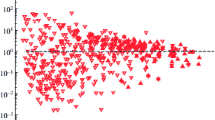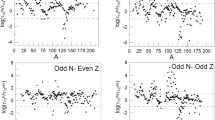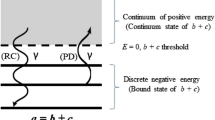Abstract
In this work, nucleosynthesis of heavy nuclei in the r-process is modelled. The influence of beta-decay rates calculated within different theoretical models on abundance of heavy nuclei is studied. It is shown that dynamics of nucleosynthesis of new elements and final abundance of heavy nuclei strongly depend on the beta-decay model used in calculations of the r-process. A possibility of using astrophysical calculations for testing predicted nuclear data defined only theoretically is discussed.


Similar content being viewed by others
REFERENCES
I. V. Panov, “What path the r-process takes: Extreme cases and comparison with observations,” Astron. Lett. 29, 163—169 (2003).
I. V. Panov and Yu. S. Lutostansky, “Dependence of the abundance of nuclei formed in the r-process on the rate of nucleosynthesis,” Yad. Fiz. 83, 349—355 (2020).
E. M. Burbridge et al., “Synthesis of the elements in stars,” Rev. Mod. Phys. 29, 547–650 (1957).
P. A. Seeger, W. A. Fowler, and D. D. Clayton, “Nucleosynthesis of heavy elements by neutron capture,” Astrophys. J. 11 (Suppl.), 121—166 (1965).
C. Sneden et al., “Evidence of multiple r-process sites in the early galaxy: New observations of CS 2289220521,” Astrophys. J. Lett. 533, L139–L142 (2000).
L. Huedepohl et al., “Neutrino signal of electron-capture supernovae from core collapse to cooling,” Phys. Rev. Lett. 104, 251101 (2010).
S. I. Blinnikov et al., “Exploding neutron stars in close binaries,” Sov. Astron. Lett. 10, 177–179 (1984).
F.-K. Thielemann et al., “Neutron star mergers and nucleosynthesis of heavy elements,” Annu. Rev. Nucl. Part. Sci. 67, 253–276 (2017).
N. R. Tanvir et al., Astrophys. J. Lett. 848, L27 (2017).
D. Watson, et al., “Identification of strontium in the merger of two neutron stars,” Nature 574, 497—506 (2019).
J. Krumlinde and P. Möller, “Calculation of Gamow–Teller β-strength functions in the rubidium region in the RPA approximation with Nilsson-model wave functions,” Nucl. Phys. A 417, 419–446 (1984).
V. G. Aleksankin, Yu. S. Lyutostanskii, and I. V. Panov, “Half-lives of nuclei far from the line of stability and the structure of the strength function of beta decay,” Sov. J. Nucl. Phys. 34, 804 (1981).
I. N. Borzov, S. A. Fayans, and E. L. Trykov, “Gamow–Teller strength functions of superfluid odd-a nuclei and neutrino capture reactions,” Nucl. Phys. A 584, 335–361 (1995).
I. N. Borzov, “Beta-decay rates,” Nucl. Phys. A 777, 645–675 (2006).
Yu. S. Lyutostansky, “Resonance structure of the charge-exchange strength function,” Yad. Fiz. 82, 440—448 (2019).
P. Möller, J. R. Nix, and K.-L. Kratz, “Nuclear properties for astrophysical and radioactive-ion beam applications,” At. Data Nucl. Data Tables 66, 131–343 (1997).
K.-L. Kratz, K. Farouqi, and B. Pfeiffer, “Nuclear physics far from stability and r-process nucleosynthesis,” Prog. Part. Nucl. Phys. 59, 147–155 (2007).
I. Panov, Yu. Lutostansky, and F.-K. Thielemann, “Beta-decay half-lives for the r-process nuclei,” Nucl. Phys. A 947, 1–11 (2016).
A. A. Staudt et al., “Second-generation microscopic predictions of beta-decay half-lives of neutron-rich nuclei,” At. Data Nucl. Data Tables 44, 79–132 (1990).
I. N. Borzov et al., “Ground state properties and β-decay half-lives near 132Sn in a self-consistent theory,” Z. Phys. 355, 117–127 (1996).
P. Möller, B. Pfeiffer, and K.-L. Kratz, “New calculations of gross b-decay properties for astrophysical applications: Speeding-up the classical r process,” Phys. Rev. C 67, 055802 (2003).
T. Marketin et al., “Microscopic calculations of β-decay rates for r-process,” Acta Phys. Pol. B 46, 641—650 (2017).
I. Yu. Korneev and I. V. Panov, “The contribution of fission to heavy-element nucleosynthesis in the astrophysical r-process,” Astron. Lett. 37,864–873(2011).
S. Rosswog et al., “Mass ejection in neutron star mergers,” Astron. Astrophys. 341, 499–526 (1999).
T. Rauscher and F.-K. Thielemann, “Astrophysical reaction rates from statistical model calculations,” At. Data Nucl. Data Tables 75, 1–351 (2000).
P. Möller et al., “Nuclear ground-state masses and deformations,” At. Data Nucl. Data Tables 59, 185–381 (1995).
Y. Aboussir et al., “Nuclear mass formula via an approximation to the Hartree–Fock method,” At. Data Nucl. Data Tables 61, 127–176 (1995).
I. V. Panov et al., “Neutron-induced astrophysical reaction rates for translead nuclei,” Astron. Astrophys. 513, A61 (2010).
I. V. Panov, I. Yu. Korneev, and F.-K. Thielemann, “r‑process in the region of transuranium elements and the contribution of fission products to the nucleosynthesis of nuclei with A@130,” Pis’ma Astron. Zh. 34, 213–221 (2008).
NuDat2 Database. 2009, http://www.nndc.bnl.gov/nudat2/.
T. Marketin, L. Huther, and G. Martínez-Pinedo, “Large-scale evaluation of β-decay rates of r-process nuclei with the inclusion of first-forbidden transitions,” Phys. Rev. C 93, 025805 (2016).
S. Goriely and M. Arnould, “What can we learn from the r-element distribution of CS 22892-052?,” Astron. Astrophys. 322, L29–L32 (1997).
F. Käppeler, F.-K. Thielemann, and M. Wiescher, “Current quests in nuclear astrophysics and experimental approaches,” Annu. Rev. Nucl. Part. Sci. 48, 175–251 (1998).
ACKNOWLEDGMENTS
The author is grateful to I.N. Borzov and Yu.S. Lyutostansky for fruitful discussions of microscopic models and to S.I. Blinnikov and A. V. Yudin for the discussion of possible scenarios of evolution of close binaries.
Author information
Authors and Affiliations
Corresponding author
Ethics declarations
The work was supported by the Russian Science Foundation, project no. 21-12-00061.
Additional information
Translated by M. Potapov
Rights and permissions
About this article
Cite this article
Panov, I.V. Beta-Decay Rate as an Important Factor of Production of Heavy Nuclei in the r-Process. Phys. Part. Nuclei 54, 660–664 (2023). https://doi.org/10.1134/S1063779623040251
Received:
Revised:
Accepted:
Published:
Issue Date:
DOI: https://doi.org/10.1134/S1063779623040251




